Ancient hairstyles- familiar with old styling

People owned hairdressing in ancient times and the evidence of this has come down to us in architecture, canvases of artists and painting household items and interiors. Even in ancient Egypt, they knew about wigs and dyeing strands, and in ancient Greece, perm was popular. Of course, all these antiquity hairdressing techniques very vaguely resemble modern, and ancient hairstyles are significantly different from the fashionable styles of women of our days.
But the fact that hairstyles have existed for many centuries, says about the desire of women to beautify themselves and stand out among their fellow tribesmen at all times. Ancient hairstyles served as the beginning of the development of the hairdressing industry, and everything that we have today has been created for centuries by our ancestors. What was the ancient hairstyle, how women were contrived, creating it, about this in the article.
Ancient hairstyles egyptian
Distinctive features:
- Wigs of dark colors.
- Dear massive jewelry.
- Braids and weaving.
- Scarves - clafts.
Fashionable in recent years, the hairstyle of the square has been known in ancient Egypt. The rich Egyptian women wore wigs with faux-coal-black wigs, cutting the bob with a straight edge and a length slightly below the face or shoulder length. The combination of even thick bangs and parting in the center is associated with the styling of ancient Egypt, where geometric lines were present throughout. Egyptian women were familiar with such a natural dye as henna and actively used it. In some ancient sources one can see not only black and brown hair in Egyptian women, but even blue and red hair.
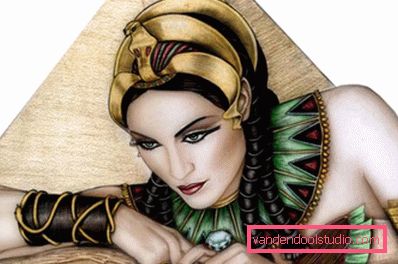
Hairstyles of ancient Egypt were decorated with massive accessories made of precious metals and stones, but, of course, only rich women could afford it. Combs, hairpins, tiaras, wreaths, temporal pendants — all these hair accessories already at that time were an indicator of the status of a woman. Simple girls rarely could afford even a wig, they used a variety of weaving techniques, covering their heads with hundreds of braids. Of course, similar Egyptian women did not have such precious ornaments. The decoration of the head of Egyptian women of different classes was a scarf-claft. He was tightly tied on his head, his ears remained open, and the ends of the scarf fell on his chest.
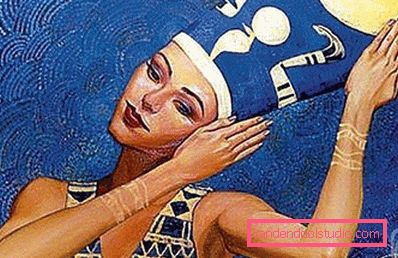
The hairstyles of ancient Egypt are specific and colorful: while in other countries the long head of hair was the possession of women, the rich Egyptian women shaved off their hair to wear wigs.
Laying Greek women in antiquity
Distinctive features:
• Curling hair on Kalamis rods. • Lightening strands. • Assembled styling with elegant decorations.
Hairstyles of ancient Greece, though modified and modernized, are still relevant to women. It is believed that the first hairdressers appeared here, called them kalamistrami. These were slaves who were trained in hairdressing in a narrow direction: one slave knew how to curl locks, another to cut, third to weave, fourth to dye. Slaves were only among noble women, simple Greek women did their own styling.
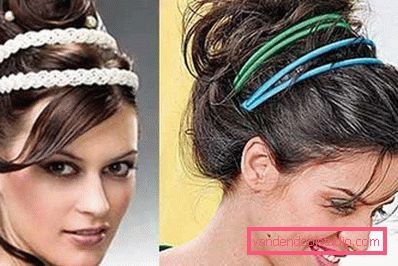
Greek women by nature endowed with dark strands. However, the hairstyles of ancient Greece on the canvases of artists have a red and blond color. Noble Greek women lightened their strands with alkaline compositions, bringing their hair closer to the ideal of that era - golden curls. The secrets of lightening hair were well known to the kalamistram of Greece: strands were clarified with rice and wheat flour, natural oils were used. For ceremonial events, they literally showered their hair with gold, or more precisely with gold powder. Kalamistra knew about the healing properties of plants and used plant extracts to care for curls.
Curling was one of the most popular methods of the calamist. In ancient Greece, they made both cold and hot perm, winding strands on iron twigs. From the spirals obtained was collected a beautiful ancient hairstyle, which was fixed with ribbons, brooches, hairpins. Laying patterns were varied. Notable Greek women adorned their hair with diadems, crowns, and stefano. These accessories were made of expensive materials, inlaid with stones.
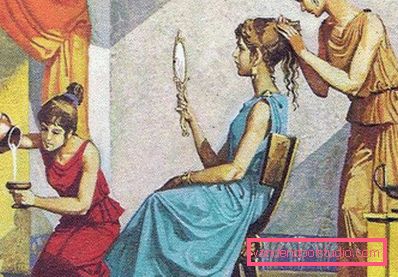
In ancient Greece, hairstyles of ancient times with ribbons of thin ribbons, leather and precious metals were popular. These headbands passed through the hairline on the forehead and went behind the ears. Curled strands gathered at the back and were gradually fixed on the back of the head. This Greek styling was adopted by modern stylists and became very popular last season. Every modern beauty had a similar bezel to create this styling for herself at home. This once again confirms that everything new is well forgotten old, and fashion is cyclical.
How in ancient times Roman women decorated their hair
Distinctive features:
- Frame laying tatulus.
- Using first styling products.
- Fashionable direction - coloring strands.
- Natural light wigs.
The hairstyles of ancient Rome were subject to a very complex evolution. Changing from simple knots at the crown, decorated with ribbons and combs, to complex and even bulky head of hair with wrappings and frame structures. Ancient Rome introduced such know-how of those times as curling irons, hair curlers and styling frames that were attached to the head and closed with strands. These frames made it possible to create the incredibly complex, high styling that the Roman women loved so much. Such masterpieces on her head made several slaves at once, and of course, it was a sign of the high status of a woman. This masterpiece was called "tutulus".
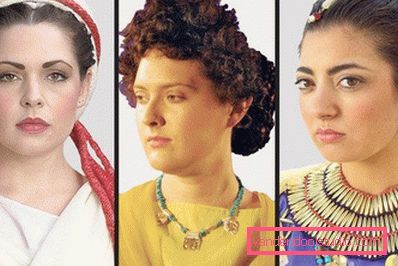
In ancient Rome, began to use the first styling tools, because such complex hairstyles needed additional fixation. Hair coloring in the Roman women was very popular. Mostly natural plant materials were used for dyeing, and blond was achieved using alkaline soap.
Not all Roman women could boast a magnificent head of hair, so in order to be in a trendy stream and do high styling, women wore wigs from natural hair. Fashionable were blond shades of wigs.
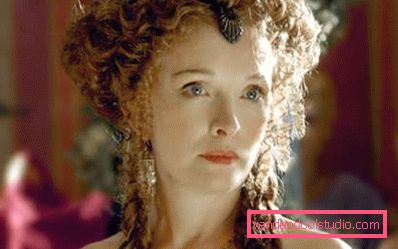
Roman women adopted the experience of Greek women, step by step gathering strands on the back of their heads, wrapping their head around with ribbons. The hairstyles of ancient Rome were decorated with pendants, diadems of precious metals, brooches, but unlike Ancient Greece, the Roman women placed greater emphasis on the beauty of the hair itself, and not on the accessories.
Hairstyles of Ancient Russia
Distinctive features:
- Naturalness
- Long strands, collected in braids.
- Jewelry - hoops and kokoshniki.
- The symbolism of the elements of hair.
The thick long braid was considered the standard of beauty in Russia at all times. In the archaeological excavations, special combs were found for combing thick hair. The braid was a sign of the marital status of the girl: unmarried wore one braid, and two were married women.
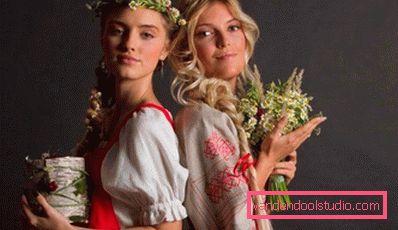
The hairstyles of Ancient Russia were decorated with headbands that simple Russian beauties made on their own, sheathing a skeleton of birch bark with a cloth, and then decorating with stones, beads, and colored ribbons. The ribbons woven into the braids were symbolic, they meant that the girl was for marriage or she had a bridegroom.
Women of ancient Russia paid great attention to the health of their hair. Broths of herbs, such as nettle, chamomile, burdock, were used as strengthening agents. These beauty instructions are still used by women. For softening strands used dairy products. In Russia, prized natural beauty and the girls knew the secrets of nature to care for their appearance.

Vintage hairstyles are of particular value for modern stylists and hairdressers. Often, the techniques and elements of ancient times become fashionable again, acquiring a new life.